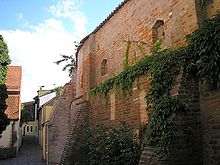City fortifications Friedberg (Bavaria)

The medieval city fortifications of Friedberg ( Aichach-Friedberg district , Swabia ) were built from 1409 as a border fortress for the dukes of Bavaria-Ingolstadt against nearby Augsburg and to secure the customs office at the Lech crossing (Hochzoll). In addition to large parts of the curtain wall, the stumps of 14 defensive towers have also been preserved; the gates were removed in the 19th century.
history
The Friedberg was already in 1257 as an advanced bulwark against the city of Augsburg. The city was founded in 1264 by Duke Ludwig II, the "Gebarteten". (Memorial stone in the parish church). The plan of the planned city is attached to the founding deed, the chessboard-like layout is still recognizable today. Friedberg is one of the numerous cities founded in the 13th century in Old Bavaria, other planned cities with an approximately square floor plan are Neustadt an der Donau or Kelheim . The original fortification of the settlement consisted only of a palisade wall, but a brick wall is already occupied by 1400.
The partially preserved fortifications were built in brick from 1409. The exposed strategic location of the ducal city at the gates of the imperial city of Augsburg led to numerous war-related devastation, which made it necessary to strengthen the fortifications. The Augsburgers attacked the ducal city for the first time in 1296. Further attacks took place in 1372 and 1388. In the 15th century, the city suffered badly during the clashes between the Munich and Ingolstadt dukes.
Even after the considerable destruction during the Thirty Years' War , it was rebuilt on the original floor plan. In 1703, imperial troops partially demolished the fortification ( War of the Spanish Succession ).
The gates and some sections of the wall fell in the 19th century. Other fortification sections were built over, the walls mostly included as external walls in residential buildings.
description
The old town of Friedberg is located south of the castle on the Lechleite , which rises 50 to 60 meters above the Lech Valley. The elevated location already meant effective protection against attacks from the Lech plain, which was supplemented by the strong fortifications and the castle.
In the west the wall rises directly above the steep slope. In the north-west the castle (former castle ) is connected to the city fortifications by a connecting wall, the corresponding north-east wall section has been removed.
The regular floor plan (approx. 350 x 300 meters) reveals the planned layout of the city. On the Lechrain, the course of the wall follows the natural slope edge in an arc to the northeast, then an open space and the neck ditch separate the town and castle.
Most of the curtain wall is built over and incorporated into the building, the former dry moat is filled. The west side towards the Lech Valley has survived best. Here the fortification is partially free and at the original height of around five meters. Buttresses support the structure. The approach of the former battlements is clearly recognizable , and some loopholes (key notches in niches) can also be seen. A short section of the battlements was reconstructed in the southwest.
Outwardly, the stumps of several semicircular shell towers protrude from the wall, the backs of which were previously open so as not to offer any cover to an enemy who had entered. The towers are usually closed by sloping pent roofs. The corner towers of the curtain wall are round. The water tower (water reservoir 1604–1888) in the southwest has a 17th century structure, its southeast counterpart collapsed in 2003 during construction work.
The former "Untere or Augsburger Tor" was removed as early as 1793 in the course of the mountain road regulation (memorial plaque next to the gap in the wall). Around 1812 the "Jägertor" fell between the city and the castle, and in 1868 the five-storey "Obere or Münchner Tor" in the east also fell.
literature
- Sebastian Hiereth: The district courts Friedberg and Mering . Historical Atlas of Bavaria, part of Swabia, 1; 1, Commission for Bavarian State History, Munich 1952.
- Karen Ostertag, Manfred Dilling; Text: Hubert Raab: City Views Friedberg . Augsburg 1986.




